Writing a Universal Chess Interface (UCI) Client in Java
I love chess; it’s just that chess doesn’t love me back.
Recently my interest in chess surged (I blame Corona), so I’ve decided to write a set of tools for creating statistics about my games - I am a programmer, after all.
My plan was to build something straightforward, you know, the type of statistics that would answer simple questions like:
- Which opening I am the most successful with;
- How good I am compared to my opponent after (let’s say), move 10;
- How often do I blunder pieces in blitz;
- etc.
So my first reaction (as a programmer) was to find a Java library that “connects” to Stockfish (or to a similar open-source chess engine) and do the works for me. Little did I know: no maintained Java library does that.
After doing my research, I’ve found out that most modern chess engines implement a protocol called UCI. UCI stands for Universal Chess Interface. It’s good that we have a standard, right?
Well, wrong. UCI is quite arcane, judging by today’s standards. There’s no REST API waiting to be consumed. You are not even connecting through a Network Socket. No! UCI uses OLD-SCHOOL process communication through stdin and stdout. And here the fun begins.
Technically there is documentation (protocol specification can be found here or here or here), but it’s not the type of documentation that holds you by the hand, and can be used without a little “reverse engineering” and “do it by yourself” testing.
This article explains how you can write your own UCI Client in Java, but I suppose you can apply the same knowledge in any other programming language.
The full-code is on github: neat-chess.
Working with an UCI-enabled engine from the command line
Installing Stockfish (and Leela Zero)
The first step was to install Stockfish as a command-line utility. If you are on *NIX, most package managers have it in the repo.
For example, on MAC it was:
brew install stockfish
On Ubuntu I suppose it is:
sudo apt-get install stockfish
On Windows:
Why are you using Windows for programming?
After installation, to start Stockfish, just type stockfish in your terminal.
Another exciting engine to work with is Leela Chess Zero. You can install this as well from the command line: brew install lc0.
Listing supported options
As per protocol definition, the first command you need to submit is uci. After the engine receives uci on its stdin, it will initialize the UCI interface and identify itself with a line starting with id name.
Then, all the supported options the engine implements are going to be listed on lines starting with option name <option_name> type ....
After successful initialization, the engine will always print on the output: uciok.
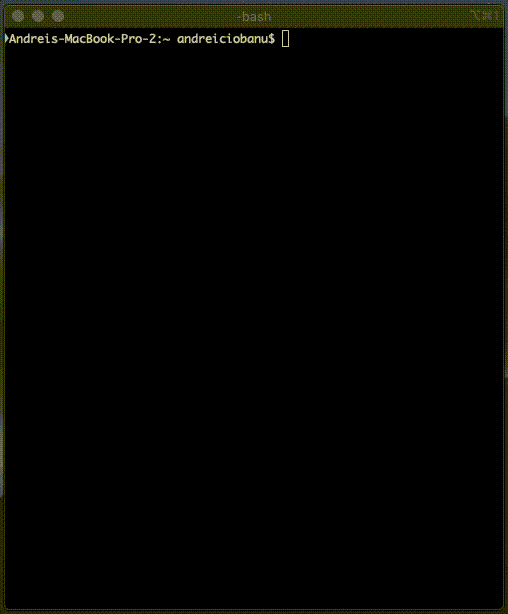
Make no assumption, the list of supported options are not standard. For example Leela Chess Zero output is different:
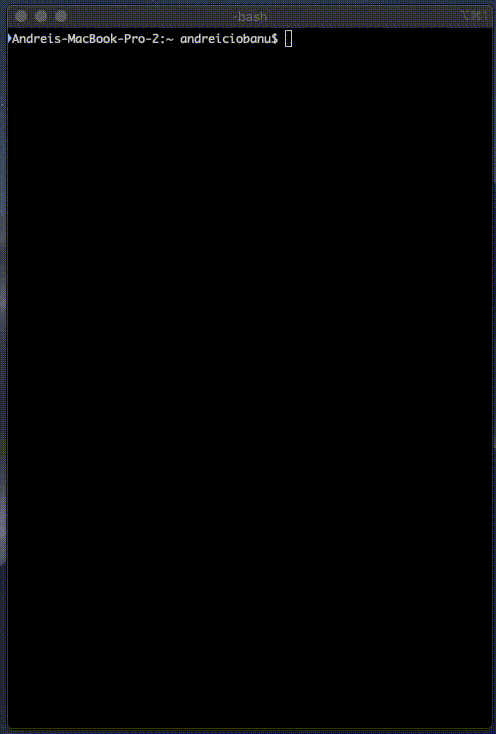
Each option has a type: check, spin, combo, button and string. It’s essential to notice this, especially when you want to set them or parse them.
| Option type | Description | Example line |
|---|---|---|
check |
The option can be true or false |
option name Ponder type check default false |
spin |
The option can be a number in a given range [min, max]. |
option name MultiPV type spin default 1 min 1 max 500 |
combo |
The option has predefined values (Strings) | option name Analysis Contempt type combo default Both var Off var White var Black var Both |
button |
The option doesn’t have any value but can be used to signal to the engine to do something | option name Clear Hash type button |
string |
As the name suggests | option name EvalFile type string default nn-62ef826d1a6d.nnue |
Now, in the original specification, the following options are listed, but this doesn’t mean an engine is limited those.
| Option name | Description |
|---|---|
Hash |
The value in MB for memory for internal hash tables. |
NalimovPath |
This is the path to the Nalimov table bases. |
NalimovCache |
The internal cache the engine uses for Nalimov tables bases. |
Ponder |
This means that the engine can ponder. The client will send this whenever pondering is possible or not. |
OwnBook |
This means that the engine has its book, which is accessed by the engine itself. |
MultiPV |
The engine supports multi-best line or k-best mode. the default value is 1. |
UCI_ShowCurrLine |
The engine can show the current line it is calculating. |
UCI_ShowRefutations |
The engine can show a move and its refutation in a line. |
UCI_LimitStrength |
The engine can limit its strength to a specific Elo number. |
UCI_Elo |
The engine can limit its strength in Elo within this interval. |
UCI_AnalyseMode |
The engine wants to behave differently when analyzing or playing a game. For example, when playing, it can use some kind of learning. This is set to false if the engine is playing a game. Otherwise, it is true. |
UCI_Opponent |
With this command, the GUI can send the name, title, ELO, and if the engine is playing a human or computer to the engine. |
Changing an option
To change the value of an existing option we can use:
setoption name <option_name> value <value>
For example, is we want the engine to enter Analyse Mode (UCI_AnalyseMode) and then to support five analysis lines (MultiPV), we need to write:
setoption name UCI_AnalyseMode value true
setoption name MultiPV value 5
As a best practice, after sending a synchronous command to the engine, it’s best to issue another command: isready.
isreadyThis must be sent when the engine has received an “isready” command and has processed all input and is ready to accept new commands now. It is usually sent after a command that can take some time to be able to wait for the engine, but it can be used anytime, even when the engine is searching, and must always be answered with “isready”.
So the current order of the commands should be:
setoption name UCI_AnalyseMode value true
setoption name MultiPV value 5
isready
Real-time example:
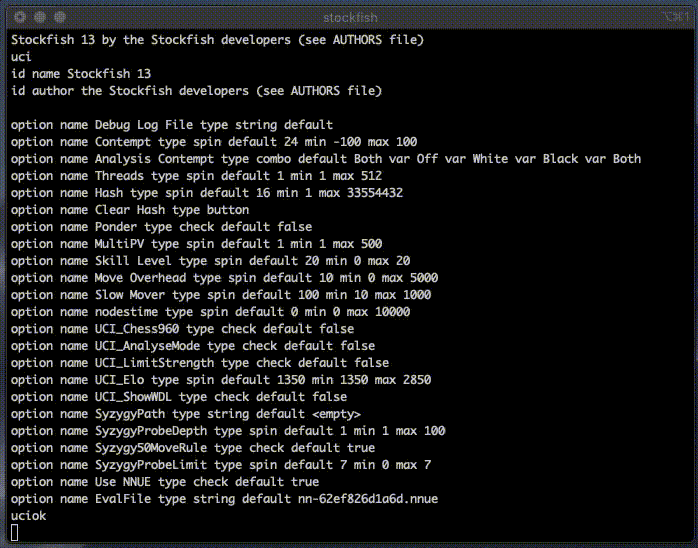
Analysing a position
A UCI-enabled chess engine uses FEN (Forsyth–Edwards Notation) to read a given position.
The Wikipedia article on the Forsyth–Edwards Notation is quite detailed, so I am not going to describe how a FEN String is formatted, but what’s important to note is that the FEN format only contains a “snapshot” of the chessboard at a given moment.
On the other hand, the other popular chess format, PGN (Portable Game Notation) contains the whole game.
UCI-enabled chess engines understand FEN, not PGN.
Before analyzing a position, it’s best to use ucinewgame to clear the engine state from previously studied positions. Because sometimes ucinewgame takes longer than expected, it’s best to test the command has finished by also triggering an “isready” command.
The next step is to set a new position for the engine. This is done using the command:
position fen <FEN>
Let’s take as an example the following position (it’s a simple mate in 3, with Black to move):
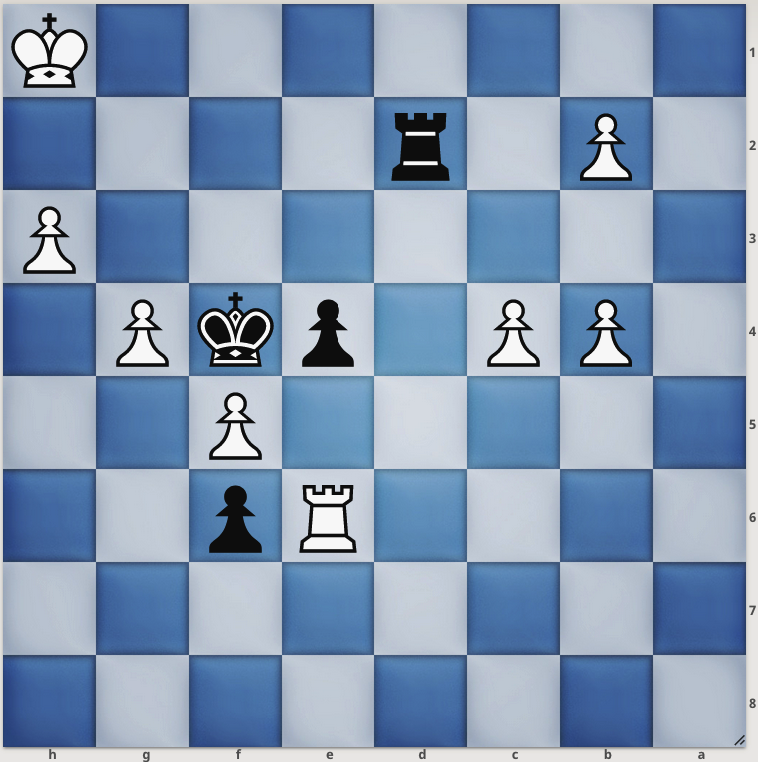
The corresponding FEN for it is: 8/8/4Rp2/5P2/1PP1pkP1/7P/1P1r4/7K b - - 0 40. This is the String the engine will understand.
ucinewgame
position fen 8/8/4Rp2/5P2/1PP1pkP1/7P/1P1r4/7K b - - 0 40
At this point we can ask the engine to analyse the given position using go <params>.
go movetime 1000
The above command will force the engine to only think for 1 second. But I am sure that 1 second is enough for it to find the mate in 3.
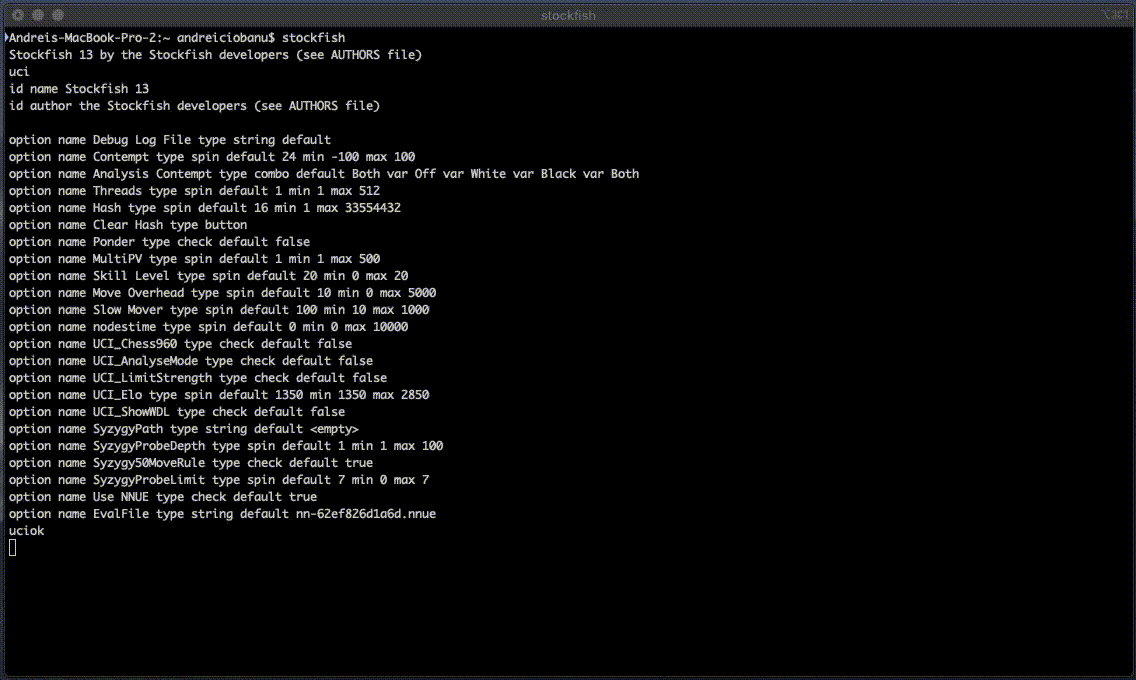
If you look at the last two lines of the output:
info depth 245 seldepth 6 multipv 1 score mate 3 nodes 143187 nps 3579675 tbhits 0 time 40 pv f4g3 e6e4 d2d1 e4e1 d1e1
bestmove f4g3 ponder e6e4
You will see that Stockfish suggests moving the piece from f4 to g3 (the Black King), and he also recognized the mate in 3.
UCI-enabled chess engines use a from-move-to-move notation, so you will usually need a chessboard in parallel so you can see what piece is moving.
The go command can be used together with other params. The most interesting is depth that specifies the engine how deep the analysis should be (e.g.: 18 moves).
go depth 18
Writing the Java UCI Client library
As we’ve seen in the previous sections, a UCI-enabled chess engine works like this:
- You open the chess engine process;
- You write commands to the process’s
stdin; - You read the results of the process’s
stdout; - It’s impossible to make an estimation regarding the time the engine spends to analyze a position;
- An engine-process cannot only work at a single position at a time. If you need to analyze more positions in parallel, you need to open more processes;
Opening and closing the engine process
In order to open a process in Java, the Process and ProcessBuilder classes can be used:
public class Client {
private Process process = null;
private BufferedReader reader = null;
private OutputStreamWriter writer = null;
public void start(String cmd) {
var pb = new ProcessBuilder(cmd);
try {
this.process = pb.start();
this.reader = new BufferedReader(new InputStreamReader(process.getInputStream()));
this.writer = new OutputStreamWriter(process.getOutputStream());
} catch (IOException e) {
e.printStackTrace();
}
}
public Client() { }
// -----
}
Notes:
- The
BufferedReader readerwill be used to read data from the process:reader.readLine(); - The
OutputStream writerwill be used to write data to the process:writer.write().
So given the above code, if we want to start a new stockfish process (assuming stockfish is already installed as a command-line utility), we can simply call:
var client = new Client();
client.start("stockfish");
At this point, we can continue by writing a close() method for the client. This method would close the “external” process and the associated buffered reader (reader) and stream writer (writer).
public void close() {
if (this.process.isAlive()) {
this.process.destroy();
}
try {
reader.close();
writer.close();
} catch (IOException e) {
e.printStackTrace();
}
}
So the way we will use the client in the future would be like this:
var client = new Client();
client.start("stockfish");
// do some work with the client
client.close();
Writing a generic method that sends commands to the engine
The way I would design a method like this is the following:
- The method should have a
timeoutparam. The reason is simple: we cannot estimate how much time the engine would spend on analyzing a move, and we want the execution to stop eventually. - To impose a
timeouton a method in Java, the only reliable way to do it is to wrap the execution inside aCompletableFuture, and then useCompletableFuture.get(timeout); - The method should block the
Threadon which the request is running until the results from the engine are returned, or the request timeouts. - Blocking the
Threadshould be done in order to avoid sending requests to the engine process in parallel - the engine wouldn’t be able to handle more than one request/command. - Our method should be a higher-order function, that takes the following functions as arguments:
Function<List<String>, T> processor- this param will process the lines coming from the engine (as aList<String>) and transform them into the desired outputPredicate<String> break- this param represents the condition on which we are no longer expect any more input from the previous request.
Given this, a method like this will look like:
public <T> T command(String cmd, Function<List<String>, T> commandProcessor, Predicate<String> breakCondition, long timeout)
throws InterruptedException, ExecutionException, TimeoutException {
// This completable future will send a command to the process
// And gather all the output of the engine in the List<String>
// At the end, the List<String> is translated to T through the
// commandProcessor Function
CompletableFuture<T> command = supplyAsync(() -> {
final List<String> output = new ArrayList<>();
try {
writer.flush();
writer.write(cmd + "\n");
writer.write("isready\n");
writer.flush();
String line = "";
while ((line = reader.readLine()) != null) {
if (line.contains("Unknown command")) {
throw new RuntimeException(line);
}
if (line.contains("Unexpected token")) {
throw new RuntimeException("Unexpected token: " + line);
}
output.add(line);
if (breakCondition.test(line)) {
// At this point we are no longer interested to read any more
// output from the engine, we consider that the engine responded
break;
}
}
} catch (IOException e) {
e.printStackTrace();
}
return commandProcessor.apply(output);
});
return command.get(timeout, TimeUnit.MILLISECONDS);
}
The method is now generic enough to be re-used to send/retrieve various information to/from the engine.
(Re)use the command(...) method to get the best engine move
Let’s look at the previously “mate in 3” position:

As we said, the associated FEN string is: 8/8/4Rp2/5P2/1PP1pkP1/7P/1P1r4/7K b - - 0 40.
Now, we want to ask stockfish from Java what is the best move; we can re-use the command(...) method a few times and obtain the result.
var client = new Client();
var position = "8/8/4Rp2/5P2/1PP1pkP1/7P/1P1r4/7K b - - 0 40";
client.start("stockfish");
// We initialise the engine to use the UCI interface
client.command("uci", identity(), (s) -> s.startsWith("uciok"), 2000l);
// We set the give position
client.command("position fen " + position, identity(), s -> s.startsWith("readyok"), 2000l);
String bestMove = client.command(
"go movetime 3000",
lines -> lines.stream().filter(s->s.startsWith("bestmove")).findFirst().get(),
line -> line.startsWith("bestmove"),
5000l)
.split(" ")[1];
System.out.println(bestMove);
client.close();
Output:
f4g3
(Re)use the command(...) to retrieve the 10 best possible moves for a position.
This task is a bit more complicated because it involves parsing non-friendly output from the engine.
By default, a UCI-enabled chess engine only retrieves the single best line it founds. To retrieve more lines and their score, we first need to set the MultiPV option to 10.
Setting an option would be as simple as:
client.command("setoption name MultiPV value 10", identity(), s->s.startsWith("readyok"), 2000l);
And now, we need to look into a format the engine retrieves the analysis line.
Let’s take the following position as an example (Ruy-Lopez):
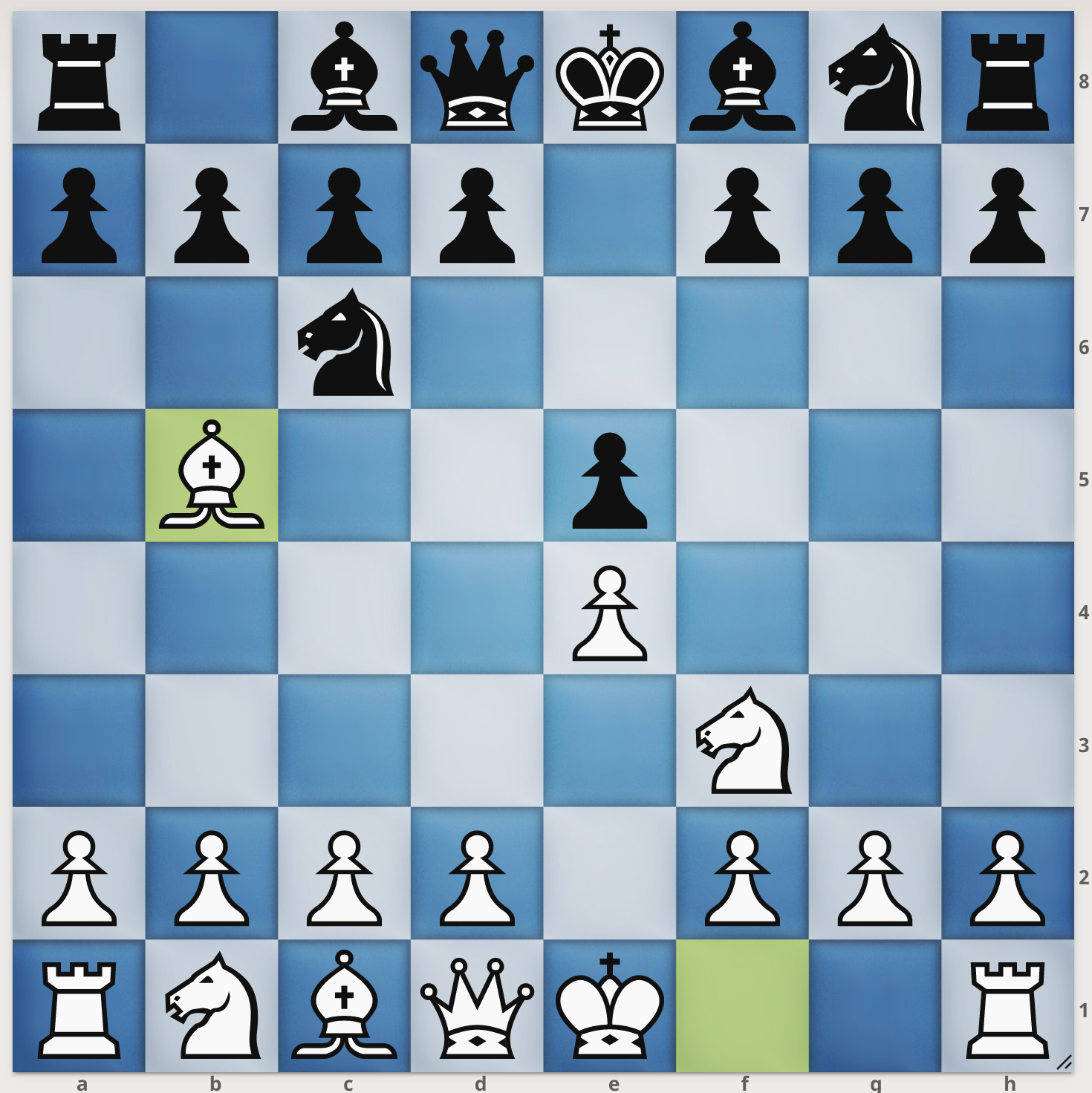
The FEN string of this position is: r1bqkbnr/pppp1ppp/2n5/1B2p3/4P3/5N2/PPPP1PPP/RNBQK2R b KQkq - 3 3.
If we want to get the ten best continuations for black starting with this position, in the command line, we will obtain the following output:
go depth 10
--- more text ----
info depth 10 seldepth 12 multipv 1 score cp -8 nodes 125667 nps 657942 tbhits 0 time 191 pv a7a6 b5a4 g8f6 d2d3 f8c5 e1g1 d7d6 d3d4 e5d4 f3d4 c8d7 d4c6 b7c6
info depth 10 seldepth 13 multipv 2 score cp -27 nodes 125667 nps 657942 tbhits 0 time 191 pv g8f6 b1c3 f8d6 d2d4 e5d4 f3d4 c6d4 d1d4
info depth 10 seldepth 13 multipv 3 score cp -28 nodes 125667 nps 657942 tbhits 0 time 191 pv f8c5 c2c3 g8f6 d2d4 c5b6 d4e5 f6e4 e1g1 e8g8 b5a4
info depth 10 seldepth 13 multipv 4 score cp -31 nodes 125667 nps 657942 tbhits 0 time 191 pv g8e7 e1g1 e7g6 b5a4 f8e7 c2c3 e8g8 d2d4 d7d6 g1h1
info depth 10 seldepth 12 multipv 5 score cp -33 nodes 125667 nps 657942 tbhits 0 time 191 pv f8e7 b1c3 d7d6 d2d4 e5d4 f3d4 c8d7 e1g1 g8f6 d4f5 d7f5 e4f5
info depth 10 seldepth 13 multipv 6 score cp -61 nodes 125667 nps 657942 tbhits 0 time 191 pv d7d6 d2d4 g8f6 d4e5 f6e4 b5c6 b7c6 e1g1 c8g4 d1d4
info depth 10 seldepth 13 multipv 7 score cp -63 nodes 125667 nps 657942 tbhits 0 time 191 pv g7g6 d2d4 e5d4 c2c3 a7a6 b5c6 d7c6 c3d4 f8g7 c1e3
info depth 10 seldepth 13 multipv 8 score cp -65 nodes 125667 nps 657942 tbhits 0 time 191 pv h7h6 e1g1 g8f6 b1c3 f8d6 d2d4 e5d4 f3d4 c6d4 d1d4
info depth 10 seldepth 12 multipv 9 score cp -66 nodes 125667 nps 657942 tbhits 0 time 191 pv c6d4 f3d4 e5d4 e1g1 g8f6 d2d3 c7c6 b5c4 f8d6 f2f4
info depth 10 seldepth 13 multipv 10 score cp -74 nodes 125667 nps 657942 tbhits 0 time 191 pv f8d6 d2d4 e5d4 e1g1 g8e7 c2c3 a7a6 b5c4 b7b5 c4b3 d4c3 b1c3 e7g6
The relevant output for us is:
info depth <depth> seldepth <...> multipv <line> score cp <score> nodes <...> nps <...> tbhits <...> time <...> pv <move1> <move2> ...
Were:
depthrepresents how deep the engine has searched;linerepresents the line suggested by the engine (smaller is better);scorerepresents the score of the move (bigger is better);move1represents the actual move the engine suggests.move2,move3, … represent the best continuations on that line from the engine point of view.
In case the line leads to a forced mate in 1,2,3,4,5… moves, the output is a little different. No score will be shown so instead of: score cp <score>, the line will contain score mate <number>.
The first thing that comes to find is to write a regex that can capture the data we need using groups.
I am no expert in writing regular expressions, but after some effort, I’ve come to write the following:
info depth ([\w]*) seldepth [\w]* multipv ([\w]*) score (cp ([\-\w]*)|mate ([\w*])) [\s\w]*pv ([\w]*)\s*([\s\w]*)

So if you look closely, the data is captured in the groups as follows:
group1contains the depth;group2contains the line;group3contains the score string (eithercp scoreormate number);group4it the actualscore;group5it thenumberof moves to mate;group6is the actual move;group7is the next move for that particular line.
group5andgroup4are mutually exclusive.
Now that we have the regex in place, it’s easy to write the actual command that extracts the best 10 moves from a given position. The code is the following:
var client = new Client();
var position = "r1bqkbnr/pppp1ppp/2n5/1B2p3/4P3/5N2/PPPP1PPP/RNBQK2R b KQkq - 3 3";
var analysisLineRegex = "info depth ([\\w]*) seldepth [\\w]* multipv ([\\w]*) score (cp ([\\-\\w]*)|mate ([\\w*])) [\\s\\w]*pv ([\\w]*)\\s*([\\s\\w]*)";
final var pattern = Pattern.compile(analysisLineRegex);
client.start("stockfish");
// We initialise the engine to use the UCI interface
client.command("uci", identity(), (s) -> s.startsWith("uciok"), 2000l);
// We set MultiPV to 10
client.command("setoption name MultiPV value 10", identity(), s->s.startsWith("readyok"), 2000l);
// We set the give position
client.command("position fen " + position, identity(), s -> s.startsWith("readyok"), 2000l);
Map<Integer, String> bestMoves =
client.command(
"go depth 18",
lines -> {
Map<Integer, String> result = new TreeMap<>();
for(String line : lines) {
var matcher = pattern.matcher(line);
if (matcher.matches()) {
Integer pv = Integer.parseInt(matcher.group(2));
String move = matcher.group(6);
result.put(pv, move);
}
}
return result;
},
s -> s.startsWith("bestmove"),
50000l);
bestMoves.forEach((k,v) -> {
System.out.printf("%d %s\n", k, v);
});
client.close();
With the following output:
1 g8f6
2 f8c5
3 a7a6
4 f7f5
5 f8e7
6 g8e7
7 d7d6
8 c6d4
9 h7h6
10 f8d6
Going further
The above code is nasty, and it can become unreadable quickly, but it’s just a starting point/foundation for a full-fledged UCI client library.
Normally, from a design perspective, the command(...) method is generic enough not to be public in your library API.
Instead of letting the developers use command(...) directly, specialized methods should be built.
In this regard, please take a look at neat-chess. This is already a working library that was tested with Stockfish 13.
Behind the scenes, neat-chess uses the same mechanism as described in this article. But on top of the command() method, I’ve built additional abstractions to make everything more readable.
For example, the previous code, can be written using neat-chess as simple as:
var client = new UCI();
client.startStockfish();
client.setOption("MultiPV", "10");
client.positionFen("r1bqkbnr/pppp1ppp/2n5/1B2p3/4P3/5N2/PPPP1PPP/RNBQK2R b KQkq - 3 3").getResultOrThrow();
var analysis = client.analysis(18).getResultOrThrow();
var moves = analysis.getAllMoves();
// Output
moves.forEach((idx, move) -> {
System.out.println(move);
});
client.close();
With the following output:
Move{lan='g8f6', strength=-0.13, pv=1, depth=18, continuation=[d2d3, f8c5, c2c3, e8g8, e1g1, d7d5, e4d5, d8d5, b5c4, d5d6, b1d2, c5b6, d2e4, f6e4, d3e4]}
Move{lan='f8c5', strength=-0.31, pv=2, depth=18, continuation=[c2c3, g8f6, d2d4, e5d4, e4e5, f6e4, c3d4, c5b4, b1d2, e8g8, a2a3, b4d2, c1d2, d7d6, e1g1, e4d2, d1d2, c8e6]}
Move{lan='a7a6', strength=-0.4, pv=3, depth=18, continuation=[b5a4, b7b5, a4b3, g8f6, e1g1, c8b7, d2d3, f8c5, a2a4, d7d6, a4b5, a6b5, a1a8, b7a8, b1c3, c6a5, c1g5, a5b3, c2b3]}
Move{lan='f7f5', strength=-0.46, pv=4, depth=18, continuation=[d2d3, f5e4, d3e4, g8f6, e1g1, d7d6, b1c3, f8e7, b5c4, c6a5, c4d3, c8g4, h2h3, g4h5, f1e1, e8g8, c3d5, a5c6, c2c3, f6d5, e4d5]}
Move{lan='f8e7', strength=-0.46, pv=5, depth=18, continuation=[e1g1, g8f6, f1e1, d7d6, c2c3, a7a6, b5a4, b7b5, a4b3, e8g8, h2h3, c6a5, b3c2, c7c5, d2d4, d8c7, b1d2, c5d4, c3d4]}
Move{lan='g8e7', strength=-0.52, pv=6, depth=18, continuation=[b1c3, g7g6, d2d4, e5d4, c3d5, e7d5, e4d5, d8e7, b5e2, c6e5, f3d4, f8g7, e1g1, c7c5, d4b5, e8g8, f2f4, a7a6, f4e5, a6b5]}
Move{lan='d7d6', strength=-0.53, pv=7, depth=18, continuation=[e1g1, a7a6, b5c6, b7c6, d2d4, e5d4, d1d4, g8e7, c1g5, f7f6, g5e3, c8g4, b1d2, e7g6, d4c4, d8d7, f1e1, f8e7]}
Move{lan='c6d4', strength=-0.61, pv=8, depth=18, continuation=[f3d4, e5d4, e1g1, c7c6, b5c4, g8f6, d2d3, d7d5, e4d5, f6d5, f1e1, f8e7, c1g5, f7f6, g5h4, e8g8, h4g3, c8f5, c4d5, c6d5, b1d2]}
Move{lan='h7h6', strength=-0.72, pv=9, depth=18, continuation=[e1g1, g8e7, c2c3, e7g6, d2d4, f8e7, d4e5, e8g8, b5a4, a7a5, a4b3, c6e5, f3e5, g6e5, f2f4, e5g6, g1h1]}
Move{lan='f8d6', strength=-0.78, pv=10, depth=18, continuation=[e1g1, g8e7, c2c3, e8g8, d2d4, e7g6, f1e1, d6e7, c1e3, d7d5, e4d5, e5d4, f3d4, d8d5, c3c4, d5e5, d4c6, b7c6, b5c6, e5b2, c6a8, b2a1]}

Comments